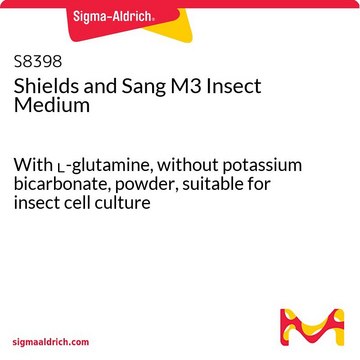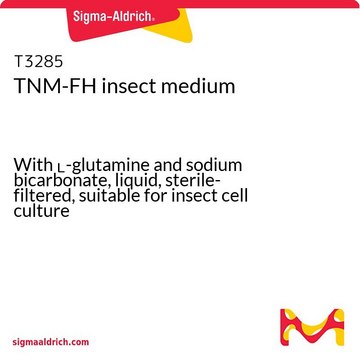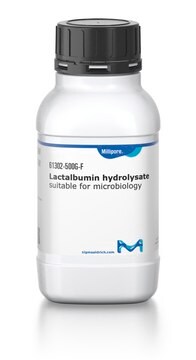S9895
Schneider′s Insect Medium
With L-glutamine, without calcium chloride and sodium bicarbonate, powder, suitable for insect cell culture
Sinonimo/i:
Schneider’s Drosophila Medium
Autenticatiper visualizzare i prezzi riservati alla tua organizzazione & contrattuali
About This Item
Prodotti consigliati
Livello qualitativo
Stato
powder
Concentrazione
24.5 g/L
tecniche
cell culture | insect: suitable
Componenti
glucose: 2 g/L (Dextro)
NaHCO3: no
L-glutamine: 1.8 g/L
Condizioni di spedizione
ambient
Temperatura di conservazione
2-8°C
Cerchi prodotti simili? Visita Guida al confronto tra prodotti
Descrizione generale
Many insect tissue culture media were formulated to mimic the main physico-chemical properties of the body fluid of specific insects. A cursory survey of the formulas of culture media designed for insect tissues reveals great qualitative and quantitative disparities in composition. Different media designed for the same species may exhibit less similarity than do two media designed for insects of different orders. Various media have been devised for the in vitro culture of Drosophila cells and tissues. The most extensively used are Schneider′s medium and Echalier and Ohanessian′s D-22 medium. Drosophila cells have been employed to study a variety of biological processes including genetics, endocrinology, physiology and cell biology as well as recombinant protein expression.
Applicazioni
Originally developed for the culture of Drosophila; suitable for culture of other dipteran cell lines.
When supplemented with 5-20% heat-inactivated fetal bovine serum, Schneider′s medium has been found to support the rapid growth of both primary and established cultures of cells derived from Drosophila melanogaster. The medium has been used for the growth and maintenance of the cell lines originally derived by Schneider from Drosophila embryos as well as the culture of cells from other dipteran species.
SCHNEIDER′S INSECT MEDIUM is one of the cell culture media available from Sigma. The selection of a nutrient medium is strongly influenced by 1] type of cell, 2] type of culture [monolayer, suspension, clonal] and 3] ° of chemical definition necessary. It is important to review the literature for recommendations concerning medium, supplementation and physiological parameters required for a specific cell line.
SCHNEIDER′S INSECT MEDIUM is one of the cell culture media available from Sigma. The selection of a nutrient medium is strongly influenced by 1] type of cell, 2] type of culture [monolayer, suspension, clonal] and 3] ° of chemical definition necessary. It is important to review the literature for recommendations concerning medium, supplementation and physiological parameters required for a specific cell line.
Nota sulla preparazione
Powdered media are extremely hygroscopic and should be protected from atmospheric moisture. The entire contents of each package should be used immediately after opening. Preparing a concentrated solution of medium is not recommended as precipitates may form.
Supplements can be added prior to filtration or introduced aseptically to sterile medium. The nature of the supplement may affect storage conditions and shelf life of the medium.
1.Measure out 80% of final required volume of water. Water temperature should be 15-20 °C.
2.While gently stirring the water, add the powdered medium. Stir until dispersed. Material will not go in solution completely. Do NOT heat water.
3.Rinse original package with a small amount of water to remove all traces of powder. Add to solution in step 2.
4.To the solution in step 3, add 0.4 g sodium bicarbonate or 5.3 ml of sodium bicarbonate solution [7.5% w/v] for each liter of final volume of medium being prepared. Stir until dissolved.
5.While stirring, adjust the pH to at least 9.2 ± 0.2 with sodium hydroxide. Stir for a minimum of 10 minutes. Solution may become turbid.
6.While stirring, adjust the pH to 6.7 ± 0.2 with HCl, solution will clear.
7.Prepare a calcium chloride solution by dissolving 0.6 g of anhydrous calcium chloride [C5670] in 50 ml of tissue culture grade water for EACH liter of final volume of medium being prepared. Slowly add the calcium chloride solution dropwise to the medium with rapid mixing to avoid precipitate formation.
8.While stirring, adjust the pH of the medium to 0.1-0.3 pH units below the desired pH since it may rise during filtration. The use of 1N HCl or 1N NaOH is recommended.
9.Add additional water to bring the solution to final volume.
10.An osmotic pressure of 360 mOsm ± 5% is suitable for the growth of cells derived from Drosophila melanogaster. If desired the osmotic pressure can be increased 10 mOsm by adding potassium chloride (0.4 g salt OR 2 ml of a 20% (w/v) solution) OR sodium chloride (0.3 g of salt OR 2 ml of a 15% (w/v) solution) for EACH liter of final volume of medium being prepared. The osmotic pressure can be decreased 10 mOsm by adding 27.8 ml of water for EACH liter of final volume of medium being prepared. Stir until dissolved.
11.Sterilize immediately by filtration using a membrane with a porosity of 0.22 microns or less.
12.Aseptically dispense medium into sterile container.
Supplements can be added prior to filtration or introduced aseptically to sterile medium. The nature of the supplement may affect storage conditions and shelf life of the medium.
1.Measure out 80% of final required volume of water. Water temperature should be 15-20 °C.
2.While gently stirring the water, add the powdered medium. Stir until dispersed. Material will not go in solution completely. Do NOT heat water.
3.Rinse original package with a small amount of water to remove all traces of powder. Add to solution in step 2.
4.To the solution in step 3, add 0.4 g sodium bicarbonate or 5.3 ml of sodium bicarbonate solution [7.5% w/v] for each liter of final volume of medium being prepared. Stir until dissolved.
5.While stirring, adjust the pH to at least 9.2 ± 0.2 with sodium hydroxide. Stir for a minimum of 10 minutes. Solution may become turbid.
6.While stirring, adjust the pH to 6.7 ± 0.2 with HCl, solution will clear.
7.Prepare a calcium chloride solution by dissolving 0.6 g of anhydrous calcium chloride [C5670] in 50 ml of tissue culture grade water for EACH liter of final volume of medium being prepared. Slowly add the calcium chloride solution dropwise to the medium with rapid mixing to avoid precipitate formation.
8.While stirring, adjust the pH of the medium to 0.1-0.3 pH units below the desired pH since it may rise during filtration. The use of 1N HCl or 1N NaOH is recommended.
9.Add additional water to bring the solution to final volume.
10.An osmotic pressure of 360 mOsm ± 5% is suitable for the growth of cells derived from Drosophila melanogaster. If desired the osmotic pressure can be increased 10 mOsm by adding potassium chloride (0.4 g salt OR 2 ml of a 20% (w/v) solution) OR sodium chloride (0.3 g of salt OR 2 ml of a 15% (w/v) solution) for EACH liter of final volume of medium being prepared. The osmotic pressure can be decreased 10 mOsm by adding 27.8 ml of water for EACH liter of final volume of medium being prepared. Stir until dissolved.
11.Sterilize immediately by filtration using a membrane with a porosity of 0.22 microns or less.
12.Aseptically dispense medium into sterile container.
Accessorio
N° Catalogo
Descrizione
Determinazione del prezzo
Comunemente ordinati con questo prodotto
N° Catalogo
Descrizione
Determinazione del prezzo
Supplemento
N° Catalogo
Descrizione
Determinazione del prezzo
Avvertenze
Danger
Indicazioni di pericolo
Consigli di prudenza
Classi di pericolo
Eye Dam. 1
Codice della classe di stoccaggio
11 - Combustible Solids
Classe di pericolosità dell'acqua (WGK)
WGK 3
Scegli una delle versioni più recenti:
Possiedi già questo prodotto?
I documenti relativi ai prodotti acquistati recentemente sono disponibili nell’Archivio dei documenti.
I clienti hanno visto anche
Weirong Jiang et al.
Journal of molecular cell biology, 11(9), 791-803 (2019-03-30)
Hedgehog (Hh) signalling plays conserved roles in controlling embryonic development; its dysregulation causes many diseases including cancers. The G protein-coupled receptor Smoothened (Smo) is the key signal transducer of the Hh pathway, whose posttranslational regulation has been shown to be
Xiao Zhang et al.
The Journal of neuroscience : the official journal of the Society for Neuroscience, 37(19), 4928-4941 (2017-04-21)
Phosphoinositides and their metabolizing enzymes are involved in Aβ
Aristeu Silva-Neto et al.
Revista da Sociedade Brasileira de Medicina Tropical, 53, e20200257-e20200257 (2020-11-12)
Biomphalaria snails may display varying levels of susceptibility to Schistosoma mansoni infection. We have been developing an in vitro model to study the interaction between the snail and the parasite, using tissue-derived cell cultures from Biomphalaria. The digestive gland- and
Alison Roth et al.
Scientific reports, 8(1), 12183-12183 (2018-08-17)
Malaria parasites transmitted by mosquito bite are remarkably efficient in establishing human infections. The infection process requires roughly 30 minutes and is highly complex as quiescent sporozoites injected with mosquito saliva must be rapidly activated in the skin, migrate through the
Xiao-Qing Ding et al.
Oncotarget, 8(47), 81953-81966 (2017-11-16)
Here, we found that ING5 overexpression resulted in a lower proliferation, reduced glucose metabolism, S arrest, decreased migration and invasion, apoptotic induction, fat accumulation, autophagy, senescence and mesenchymal-epithelial-transition of breast cancer cells. It also suppressed the tumor growth of breast
Il team dei nostri ricercatori vanta grande esperienza in tutte le aree della ricerca quali Life Science, scienza dei materiali, sintesi chimica, cromatografia, discipline analitiche, ecc..
Contatta l'Assistenza Tecnica.









